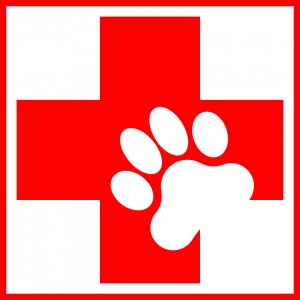 Preparing for emergencies does not stop with securing the doors and latches. Our furry friends need some extra TLC during these times to better cope with changes taking place and the disaster itself. When unexpected emergencies arise, pets tend to have increased anxiety and can react irrationally. Animals have instincts about severe weather changes and will often isolate themselves if they are afraid. If they are left outside when these instincts kick in, they may run away to find safety. This increases the chance of pets getting lost, injured or even killed. By preparing for these changes in our pet’s behavior, we can help them feel more secure, and give them what they need to cope with the situation at hand.
Preparing for emergencies does not stop with securing the doors and latches. Our furry friends need some extra TLC during these times to better cope with changes taking place and the disaster itself. When unexpected emergencies arise, pets tend to have increased anxiety and can react irrationally. Animals have instincts about severe weather changes and will often isolate themselves if they are afraid. If they are left outside when these instincts kick in, they may run away to find safety. This increases the chance of pets getting lost, injured or even killed. By preparing for these changes in our pet’s behavior, we can help them feel more secure, and give them what they need to cope with the situation at hand.
What Your Pets Need Before a Disaster Threatens
Knowing how your pet will react before, during and after a storm is the first step in ensuring their safety. Take your pet inside the home before the disaster occurs. This will help them find a secure and quiet spot for them to ride out the disaster in. Also, as a contingency plan, it is always good to have your pet’s medical documentation and emergency identification cards on hand, or included along with your emergency documents. Additionally, having some first aid supplies set aside for your pets may help ensure their safety if they happen to become injured.
Suggestions for your pet’s first aid kit:
- Phone numbers to the pet’s veterinarian
- Latex gloves
- Gauze rolls for wrapping wounds or for muzzling an injured pet.
- Gauze sponges
- Non-stick bandages, towels or towels cut in to strips to control bleeding.
- Adhesive tape, hypoallergenic
- Elastic cling bandages
- Water-based sterile lubricant
- Eye-wash or sterile saline wash
- Topical antibiotic ointment
- Petroleum jelly
- Antiseptic towelettes
- Diphenhydramine (antihistamine) – *Should be approved by your veterinarian
- Q-tips
- Milk of Magnesia or activated charcoal to absorb poison. *Call the pet’s vet first administering this.
- Hydrogen Peroxide to clean wounds and induce vomiting. *Call the pet’s vet before administering this.
- Thermometer to check your pet’s temperature.
- Eye dropper or large syringe without the needle to administer any medications orally.
- Materials to make a splint.
- Cold pack
- Small scissors
- Safety pins
- Tweezers
- Magnifying glass
- Emergency blanket
- Muzzle
- Leash
- Penlight with batteries
Ensuring our pets are as safe as the other members of the family will help all family members cope with the stressful situation. The American Red Cross offers Pet First Aid courses that could further assist you in caring for your pets when they become injured. At the very least, those who have pets should pick up a first aid manual for pets. The American Red Cross offers a pet first aid manual that can be bought online.

hanks for this list! Might I recommend mylar blankets to reflect the heat off cages when evac’ing. And if the pets are inside the vehicle, and the AC can’t run because of over-heating issues, a fan of any kind came in quite handy. A sticker in case anyone needs to leave their pets behind (let pet-loving neighbors know too). ASPCA has stickers for windows: http://www.aspca.org/pet-care/disaster-preparedness/
The Red Cross book is nearly useless, consisting mostly of “call your Vet.” Try to find “Dog Owners Home Veterinary Handbook” by Delbert G. Carlson, D.V.M. and James M. Giffin, M.D. Mine is from the mid ’90s. It is almost unbelievably complete amd concise. I have seen similar publications for other pets.
You can also pick up dry electrolyte powder from Tractor Supply. Great for an animal who is hurt, dehydrated, or heat stressed. I also keep a can of Blue-Kote spray for flesh wounds to repel flies, etc., and a few rolls of gauze and horse vet wrap – a spongy bandage material that you wrap over a gauze pad and it sticks to itself. Since I raise goats, I also keep antibiotics and syringes, also available from Tractor Supply or the feed store.